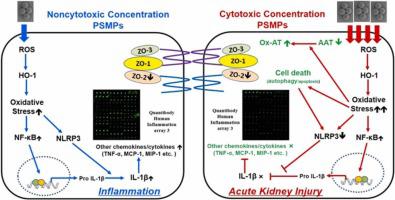Journal of Hazardous Materials ( IF 12.2 ) Pub Date : 2021-11-25 , DOI: 10.1016/j.jhazmat.2021.127871 Yi-Chun Chen, Ku-Fan Chen, Kun-Yi Andrew Lin, Jen-Kun Chen, Xin-Yu Jiang, Chia-Hua Lin

|
As microplastics (MPs) dispersed into the environment, people might be exposed to MPs. Most pollutants either pass through or concentrate in the kidney. Therefore, nephrotoxicity tests are needed to verify the toxic potential of MPs. Here we used human embryonic kidney 293 (HEK293) cells to determine the association between nephrotoxicity and round-shape polystyrene MPs (PSMPs) (3.54 ± 0.39 μm) under realistic environmental exposure concentrations. Results revealed that PSMPs can adhere to the cell membrane and get entirely engulfed by HEK293 cells. PSMPs can induce cytotoxicity by oxidative stress via inhibition of the antioxidant heme oxygenase-1. Depolarization of the mitochondrial membrane potential and formation of autophagosomes confirmed that apoptosis and autophagy can be simultaneously induced by PSMPs. The inflammatory factor was only activated (33 cytokines) by noncytotoxic concentration of PSMPs (3 ng/mL); however, the cytotoxic concentration (300 ng/mL) of PSMPs induced autophagy, which might further reduce NLRP3 expression, thus contributing to dampening inflammation (35 cytokines) in HEK293 cells. PSMPs (300 ng/mL) can impair kidney barrier integrity and increase the probability of developing acute kidney injury through the depletion of the zonula occludens-2 proteins and α1-antitrypsin. Altogether, our results demonstrated that environmental exposure to PSMPs may lead to an increased risk of renal disease.
中文翻译:

聚苯乙烯微塑料在实际环境浓度下的肾毒性潜力
随着微塑料 (MPs) 扩散到环境中,人们可能会接触到 MPs。大多数污染物要么通过肾脏,要么集中在肾脏中。因此,需要进行肾毒性试验来验证 MPs 的潜在毒性。在这里,我们使用人胚肾 293 (HEK293) 细胞来确定肾毒性与圆形聚苯乙烯 MPs (PSMPs) 之间的关联 (3.54 ± 0.39 μm) 在实际环境暴露浓度下。结果表明,PSMPs 可以粘附在细胞膜上并被 HEK293 细胞完全吞噬。PSMPs 可以通过抑制抗氧化血红素加氧酶 1 来诱导氧化应激的细胞毒性。线粒体膜电位的去极化和自噬体的形成证实了 PSMPs 可以同时诱导细胞凋亡和自噬。炎症因子仅被非细胞毒性浓度的 PSMP(3 ng/mL)激活(33 种细胞因子);然而,PSMPs 的细胞毒性浓度 (300 ng/mL) 会诱导自噬,这可能会进一步降低 NLRP3 的表达,从而有助于抑制 HEK293 细胞中的炎症(35 种细胞因子)。PSMP(300 ng/mL) 会损害肾脏屏障的完整性,并通过消耗 zonula occludens-2 蛋白和 α1-抗胰蛋白酶而增加发生急性肾损伤的可能性。总之,我们的研究结果表明,环境暴露于 PSMP 可能会导致肾脏疾病风险增加。











































 京公网安备 11010802027423号
京公网安备 11010802027423号